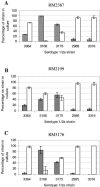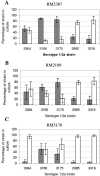Competitive fitness of Listeria monocytogenes serotype 1/2a and 4b strains in mixed cultures with and without food in the U.S. Food and Drug Administration enrichment protocol
- PMID: 16391118
- PMCID: PMC1352237
- DOI: 10.1128/AEM.72.1.776-783.2006
Competitive fitness of Listeria monocytogenes serotype 1/2a and 4b strains in mixed cultures with and without food in the U.S. Food and Drug Administration enrichment protocol
Abstract
Thirteen different serotypes of the food-borne pathogen Listeria monocytogenes have been described. Serotype 4b strains are most often associated with illness, and serotype 1/2a strains are most often isolated from foods and processing plants. Different abilities to respond to stresses have been described for serotype 4b and 1/2a strains. One of the common enrichment protocols used to test foods for the presence L. monocytogenes is described in the U.S. Food and Drug Administration (FDA) Bacterial Analytical Manual (BAM). We compared three strains of L. monocytogenes serotype 4b and five strains of serotype 1/2a in direct competition with each other in two-strain mixed cultures by using the FDA BAM enrichment protocol, which includes both enrichment broth and selective agar, with and without added food to mimic the conditions that occur during attempts to isolate Listeria species from contaminated foods. Using a colony immunoblot procedure and analyzing over 112,000 colonies, we observed differences in strain fitness, but these differences were not attributable to serotype or genetic lineage.
Figures





Similar articles
-
Bias in the Listeria monocytogenes enrichment procedure: lineage 2 strains outcompete lineage 1 strains in University of Vermont selective enrichments.Appl Environ Microbiol. 2005 Feb;71(2):961-7. doi: 10.1128/AEM.71.2.961-967.2005. Appl Environ Microbiol. 2005. PMID: 15691954 Free PMC article.
-
Listeria monocytogenes serotype 1/2b and 4b isolates from human clinical cases and foods show differences in tolerance to refrigeration and salt stress.J Food Prot. 2014 Sep;77(9):1519-26. doi: 10.4315/0362-028X.JFP-13-548. J Food Prot. 2014. PMID: 25198843
-
Growth differences and competition between Listeria monocytogenes strains determine their predominance on ham slices and lead to bias during selective enrichment with the ISO protocol.Int J Food Microbiol. 2016 Oct 17;235:60-70. doi: 10.1016/j.ijfoodmicro.2016.07.016. Epub 2016 Jul 12. Int J Food Microbiol. 2016. PMID: 27434679
-
Competition of Listeria monocytogenes serotype 1/2a and 4b strains in mixed-culture biofilms.Appl Environ Microbiol. 2009 Sep;75(18):5846-52. doi: 10.1128/AEM.00816-09. Epub 2009 Jul 31. Appl Environ Microbiol. 2009. PMID: 19648379 Free PMC article.
-
Whole genome comparisons of serotype 4b and 1/2a strains of the food-borne pathogen Listeria monocytogenes reveal new insights into the core genome components of this species.Nucleic Acids Res. 2004 Apr 28;32(8):2386-95. doi: 10.1093/nar/gkh562. Print 2004. Nucleic Acids Res. 2004. PMID: 15115801 Free PMC article.
Cited by
-
The effects of competition from non-pathogenic foodborne bacteria during the selective enrichment of Listeria monocytogenes using buffered Listeria enrichment broth.Food Microbiol. 2014 Dec;44:173-9. doi: 10.1016/j.fm.2014.05.004. Epub 2014 May 21. Food Microbiol. 2014. PMID: 25084660 Free PMC article.
-
Surveillance of Listeria monocytogenes: Early Detection, Population Dynamics, and Quasimetagenomic Sequencing during Selective Enrichment.Appl Environ Microbiol. 2021 Nov 24;87(24):e0177421. doi: 10.1128/AEM.01774-21. Epub 2021 Oct 6. Appl Environ Microbiol. 2021. PMID: 34613762 Free PMC article.
-
Effect of Listeria seeligeri or Listeria welshimeri on Listeria monocytogenes detection in and recovery from buffered Listeria enrichment broth.Food Microbiol. 2015 Apr;46:528-534. doi: 10.1016/j.fm.2014.09.008. Epub 2014 Sep 28. Food Microbiol. 2015. PMID: 25475325 Free PMC article.
-
Transient and resident pathogens: Intra-facility genetic diversity of Listeria monocytogenes and Salmonella from food production environments.PLoS One. 2022 Sep 1;17(9):e0268470. doi: 10.1371/journal.pone.0268470. eCollection 2022. PLoS One. 2022. PMID: 36048885 Free PMC article.
-
Synergistic effects of sodium chloride, glucose, and temperature on biofilm formation by Listeria monocytogenes serotype 1/2a and 4b strains.Appl Environ Microbiol. 2010 Mar;76(5):1433-41. doi: 10.1128/AEM.02185-09. Epub 2010 Jan 4. Appl Environ Microbiol. 2010. PMID: 20048067 Free PMC article.
References
-
- Bibb, W. F., B. Schwartz, B. G. Gellin, B. D. Plikaytis, and R. E. Weaver. 1989. Analysis of Listeria monocytogenes by multilocus enzyme electrophoresisand application of the method to epidemiologic investigations. Intl. J. Food Microbiol. 8:233-239. - PubMed
-
- Borucki, M. K., M. J. Krug, W. T. Muraoka, and D. R. Call. 2003. Discrimination among Listeria monocytogenes isolates using a mixed genome DNA microarray. Vet. Microbiol. 92:351-362. - PubMed
-
- Buncic, S., S. M. Avery, J. Rocourt, and M. Dimitrijevic. 2001. Can food-related environmental factors induce different behaviour in two key serovars, 4b and 1/2a, of Listeria monocytogenes? Int. J. Food Microbiol. 65:201-212. - PubMed
Publication types
MeSH terms
Substances
LinkOut - more resources
Full Text Sources
Medical
Miscellaneous

